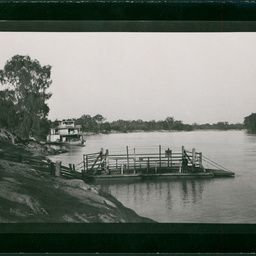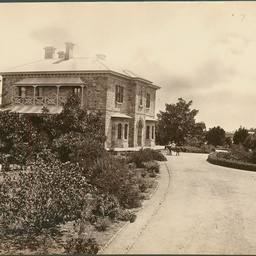Find • murray • Results 3,601 to 3,630 of 5,746


Institute, Swan Reach
Institute, Swan Reach was originally built in 1933 as the Town Hall. During its time the building was also the Institute and later the Public Hall. Swan Reach was settled in the 1850s on the Murray River between Blanchetown and Mannum. The building was built at the cost of 1200 pounds.


Swan Reach
View of the Murray River from Swan Reach.


Tailem Bend
[General description] Two rows of identical free standing cottages (possibly of concrete rendered brick) with gabled iron roofs. They all have enclosed back and front yards, the fencing mostly of brush with post and rail on the street frontage. A few people walk in the street which divides the rows of cottages. Other houses can be seen in the background. [On back of photograph] 'Reproduced in the Chronicle, May 8, 1926' (Another hand) 'The first 2 rows of cottages to be built at Tailem Bend under the new railway scheme. / 1926 / From Alfred J Gibbons / Murray Bridge'.


Tanunda
Tanunda's Murray Street showing George Fischer's Tanunda Hotel. Five small girls are standing outside. Fischer was proprietor of the hotel from 1861-1871. The Post Office can be seen a few buildings down the street next door to Christen's Fancy Bazaar. The Telegraph Station is located within the Post Office building.


Tanunda
Tanunda showing Tanunda Hotel in Murray Street. RC Sobels was the proprietor at the time of this photograph. A horse is hitched to a pole in the foreground. Two horses are pulling a cart outside the hotel


Peace march
A peace march along Murray Street, Tanunda.


Woolwashing machinery
Woolwashing machinery at Taylor Brother's works, Thebarton. They were situated on section 46, between Taylor's Bridge Road, West Thebarton Road, Murray Street and the River Torrens. Workshop machines were steam powered via overhead line shafting and belts.


Woolwashing works
[General description] The staff of Taylor Brothers are posing with wool bales in front of a brick and iron roofed building with a tall chimney. Perhaps the man in the centre (in front of the chimney) wearing a top hat and the other two men prominent in the front (sitting on wool bales) are the Taylor brothers? [On back of photograph] 'Taylor Brothers fellmongery and woolwashing works / Thebarton / About 1875 / on section between Taylor's Bridge Road, West Thebarton Road, Murray Street and the River Torrens / Absorbed later in the works of the Torrenside Woollen Mills / Photographed for the Philadelphia Expedition of 1876 by H. Davis / Presented by Mr. H. Boothby'.


Woolwashing works
[General description] Wool washing vats at Taylor Brothers'. Workers, many wearing leather aprons, are posed demonstrating their various roles. Works' buildings are seen in the background. [On back of photograph] 'Taylor Brothers fellongery and wool washing works / Thebarton / about 1875 / On section between Taylor's Bridge Road, West Thebarton Road, Murray Street and the River Torrens / Photographed for the Philadelphia Expedition of 1876 by H. Davis / Presented by Mr. H. Boothby'.


Taylor Brothers Fellmongery
[On back of photograph] 'Taylor Brothers fellongery and wool washing works / Thebarton / about 1875 / On section between Taylor's Bridge Road, West Thebarton Road, Murray Street and the River Torrens / Photographed for the Philadelphia Expedition of 1876 by H. Davis / Presented by Mr. H. Boothby'.


Scotch College, Torrens Park
Scotch College, Torrens Park was founded in 1919 as an independent Presbyterian school for boys. Headmaster Norman Murray Gladstone Gratton initiated a program of expansion and development thus in 1946 the college built a junior school - Gratton House. This was a memorial to 57 Old Collegians who were killed in World War II.


Scotch College Library
The Scotch College Library. Scotch College, Torrens Park was founded in 1919 as an independent Presbyterian school for boys. Headmaster was Norman Murray Gladstone Gratton.


Old Unley Inn
Old Unley Inn, Unley. According to a researcher, this building relates to the 74th Infantry Regiment. This was the first headquarters of the 74th Infantry Regiment, in the de-licensed Unley Inn at 158-160 Unley Road, South Australia, used from 1 July 1911 until 13 March 1915. The Unley Inn had been built in 1847-48 by William Ewens, who had come to South Australia on the Prince Regent in 1839; he was a publican in Adelaide in the early 1840s but in December 1847 he retired on 1½ acres of land at Unley where he built the Unley Inn and took out a Licence the following year. He died soon after, but his wife Sarah continued to manage the Unley Inn while living in the adjoining cottage. This photograph is from the period between May 1912 and June 1913 when the regiment was known as the 74th Infantry (Boothby Battalion): the drill hall has the title 'HEADQUARTERS BOOTHBY BATTALION', with a smaller sign above the verandah, '74th INFANTRY'. In June 1913 the battalion was redesignated 74th (Boothby) Infantry. On 13 March 1915, the new drill hall and headquarters of the 74th (Boothby) Infantry was established in Thomas Street, Unley.


Victor Harbor
View of Victor Harbor showing the causeway leading to Granite Island and buildings in the town. The horse drawn railway was extended along the Causeway to Granite Island in the mid 1860s to service large American and European clippers. Bales of wool were paddled down the Murray, freighted to Victor Harbor then shipped to the world.


Pumping Station
Pumping Station at the River Murray Village Settlement.


Aerial view of Waikerie
Aerial view of Waikerie showing the orchards and vineyards irrigrated from the River Murray along side the township. A researcher has provided the following information: the oval depicted centre base appears under construction. It has a compacted earth bike track (velodrome) around it as many in the Riverland did at the time. This oval was cleared of trees and flattened as the Waikerie Soldier's Memorial Oval in 1946 by Returned Servicemen as a tribute to the men from Waikerie who died in the War. This photograph may have been takend in 1945-1946. The oval is now the Waikerie Lions Park.


"Waikerie", River Steamer
River steamer "Waikerie" at Waikerie settlement. The steamer was built by Captain Albert Francis. It was owned by William Tinks from 1911-1926. Waikerie began as a village settlement in 1894 as part of the government scheme to open up the land along the River Murray. Bill (William) Tinks in partnership with Albert (Bert) Francis sold "Waikerie" to W & WF Bailey in 1926


Punt at Waikerie
Punt on River Murray at Waikerie. This punt operated from 1910 and was hand operated. The first crossing was made in 1910. The ferry shortened the road distance between Morgan and Renmark. A paddle steamer is moored on the bank behind the punt


Waikerie Village Settlement
Waikerie village settlement, River Murray. The Rev. Butler can be seen chopping wood, 22nd November 1894. This was one of thirteen communal settlements known as village settlements. They were created to ease the economic depression following the major strikes in the 1890's and the bank crash of 1893. Socialist ideas became popular and utopian schemes were appealing to the unemployed and those struggling to make ends meet. Disgruntled single workers left to form their own settlement at Ramco but both schemes declined and Waikerie ceased to be a village settlement in 1903 when it was incorporated into the Waikerie Irrigation Area.


Waikerie Village Settlement
Waikerie village settlement, River Murray . The Rev. Butler can be seen chopping wood, 22nd November 1894.


Residence of John Acraman
Residence of John Acraman of Walkerville. A note on the back of the photograph states "Note supplied by the Assistant District Clerk, District of Walkerville (15/11/1941) - It [building] is shown in our records as being in View Road, Walkerville, though the address used by owner is North East Road. A verandah and balcony have been added to the front of the dwelling, otherwise the present appearance (1941) is very little changed from the photograph, and it is in a good state of preservation". There is also a hand drawn map of the location of the house on the back of the photograph. John Acraman was a prominent businessman in the colony of South Australia. He had diverse business interests including coastal and River Murray shipping, insurance, pastoral management, agents for Guinness Stout. He was a keen sportsman, on the Board of Governors of St Peter's College, collector of fine arts and one of the oldest members of the Adelaide Club. He is remembered as being the father of South Australian football after he introduced the Victorian game to South Australia. The home of the Acramans called "The Grove" at Walkerville was destroyed by fire in 1876.


Waikerie Football Team
Waikerie football team. A researcher has suggested that this is the Waikerie Football Club Premiership 1911. They were part of hte Mid Murray Association.


Paddle steamer "Gem" at Waikerie
The Paddle steamer "Gem" in Lock 5 at Waikerie on the River Murray. [Researcher says Lock 5 is near Renmark, not Waikerie].


McCoy Street, Waikerie
McCoy Street, Waikerie, showing the Soldiers Memorial Institute (which was extended in 1928 by the hall at the rear of the institute). This photograph was taken from Peake Terrace, towards McCoy Street and shows th hotel on the right oppoisite the hall. The streets are decorated for Education Week. An article in the 'The Murray Pioneer and Australian River Record' on 6th September 1929, states that 'McCoy Street, the main street of Waikerie has been beflagged for Education Week - over 4000 flags and about 400 electric light globes being used in the decorations."


McCoy Street, Waikerie
McCoy Street with the hotel on the right which was nicknamed the "Snake Pit". Photograph of a postcard. [Murray views, no. 10].


Waikerie Pumping Station
Banking at Wakerie Pumping station during the Murray River flood.


Waikerie Pumping Station
Banking at Waikerie Pumping Station during the Murray River flood.


Weston Flat
The Rest and Be Thankful Hotel at Weston Flat, River Murray, near Morgan existed 1860-1906. It was known as Rest and Be Thankful, Mallyon's Hotel, Western's Flat, Weston Flat. It was known as Rest and Be Thankful from 1860-1862 when the proprietor was J MacKay.


Weston Flat Village
Weston Flat Village settlement, River Murray. This was one of thirteen communal settlements known as village settlements. They were created to ease the economic depression following the major strikes in the 1890's and the bank crash of 1893. Socialist ideas became popular and utopian schemes were appealing to the unemployed and those struggling to make ends meet.


Yalata Station
Mrs. Daisy Bates moving camp from Yalata Homestead, Yalata Station far west coast of S.A. First photograph of nine in an album of views of Mr. George W. Murray's Yalata Station Far West Coast, S.A.,1917. (plus Res. A (Album -Solander box).
